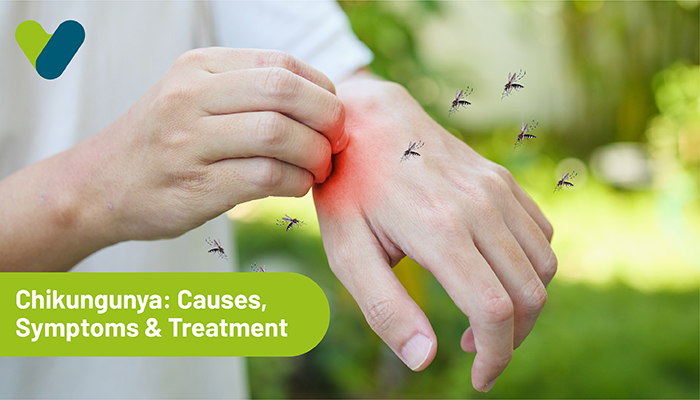What Is Chikungunya?
Chikungunya is a viral disease spread by female Aedes aegypti mosquitoes infected with the chikungunya virus (CHIKV). Chikungunya in the Kimakonde language means ‘to become contorted’ because of the debilitating joint pain that it causes.Aedes mosquitoes breed in clean water sources. These mosquitoes breed in water containers, tanks, and any discarded hollow objects like flowerpots, buckets, utensils, and tyres. Early morning or late at night are the times when the Aedes aegypti mosquitoes feed on their prey most frequently.
Chikungunya fever is found in countries in Africa, Americas, Asia, Europe, and the Caribbean, Indian and Pacific Oceans. The first case of chikungunya in India was reported in 1963.
Causes & Transmission of Chikungunya
Chikungunya is transmitted by the bite of an aedes aegypti mosquito that is already infected with the virus. The mosquito gets infected when it feeds on a person who has this virus in their bloodstream.This disease cannot be passed from a person to person. It is only transmissible through a chikungunya mosquito bite. Chikungunya virus transmission through the blood is possible. If a person shares injection needles or gets a blood transfusion from an infected person, they can have chikungunya too. There have been rare cases of in utero transmission of chikungunya from the mother to the unborn child. Chikungunya cannot be transmitted from the mother to the child through breastmilk. Even if the mother is infected with this virus, she should be encouraged to continue breastfeeding.
Most people who have been bit by an infected mosquito are symptomatic. The incubation period of the virus is around 4 to 8 days (range 1–12 days), according to the World Health Organization.
Symptoms of Chikungunya
Most people who are bit by the chikungunya mosquito will have severe symptoms. The most common symptoms of this disease are:- Fever (between 100 and 104 °C)
- Severe joint pain (arthralgia)
- Fatigue
Complication in Chikungunya
Anyone can get chikungunya. However, people who are most at the risk of being ill with chikungunya are pregnant individuals, infants and children, older adults above the age of 65 years, and individuals who have underlying medical conditions such as hypertension, a heart disease, and diabetes. People who have already been infected should be immune to future infections.Most sick people recover completely from the infection, but chikungunya has been linked with some rare instances of the eye, heart, and neurological dysfunction. This can worsen in the case of people who already have any previous medical issues.
Seizures or convulsions, jaundice caused by liver damage, heart muscle inflammation, eye infections, acute renal disease, respiratory failure, and bullous skin lesions are also some severe but rare complications of chikungunya. There have also been cases of bleeding due to these skin lesions, low platelet count (thrombocytopenia), meningoencephalitis (a neurological condition affecting the brain and neighbouring tissues), and meningitis (infection of the brain’s protective tissue called meninges).
Diagnosis of Chikungunya
If a person has any of the abovementioned chikungunya symptoms, it is best to go to a doctor. Avoid self-medicating because that can do more harm than good.Because the manifestation of chikungunya, dengue and malaria can be similar, the best way to arrive at a diagnosis is laboratory testing. A reverse transcriptase–polymerase chain reaction (RT–PCR) test can be used to detect the presence of the chikungunya virus in a person’s system accurately, especially in the first week of the illness.
A blood test will be ordered where a sample of the blood will be collected from a vein in the arm. This blood test is usually done to detect whether the body has any IgG and IgM anti-chikungunya anti-bodies that can fight the chikungunya virus. It is known as the enzyme-linked immunosorbent assay (ELISA) test. The IgM anti-body is the highest during the first 3 to 5 weeks of illness but can also be found 2 months after you fell first fell sick.
Treatment of Chikungunya
With a quick and adequate treatment, the symptoms can go away within a week. Death through chikungunya disease is mostly rare. However, the joint pain from chikungunya can remain for as long as a month.There is no vaccine to counter chikungunya as of now. Moreover, there is no specific treatment plan that is available for chikungunya. A doctor will aim to reduce fever and ease the joint pain. Analgesics like paracetamol will be prescribed to keep the fever down and relieve pain. Because chikungunya and dengue can have the same symptoms, a patient will be advised to avoid aspirin so there’s no blood loss. Resting and having enough sleep is also essential.
The patient will also be asked to keep themselves adequately hydrated because fever can cause fluid loss and dehydration. They can either do this by drinking water, fruit juices, soups, yoghurt-based drinks, coconut water or they can have oral rehydration solution (ORS) to replenish their electrolytes.
In the case of a severe case of infection, hospitalisation will be needed. A medical team will give the patient intravenous (IV) fluid and electrolyte replacement and monitor the blood pressure regularly. Fluid replacement is necessary to avoid dehydration in case the patient is vomiting, bleeding, sweating, or even diarrhoea.
Preventive Measures for Chikungunya
Knowing the causes, symptoms, complications, diagnostic tests, and treatment methods of chikungunya is always helpful. Moreover, learning about preventive steps can help avert the chances of being ill significantly. There are some simple steps that you can take, like:- Mosquito breeding increases during summer and rainy months. So, taking care of skin exposure is important. People should cover their arms and legs if they are stepping outdoors.
- Having screen doors and mesh on the windows is important so mosquitoes and other bugs cannot enter the house. Repair any holes in the mesh as well.
- Else, sleep inside a mosquito net.
- Using mosquito repellent sprays, creams, patches, and machines is also helpful. Most of these products are economically priced and are also available in bulk packs so that anyone can use them for a long time.
- People can also use natural repellents like citronella.
- Look for water-holding vessels both inside and outside of your house. If a person has a garden or a backyard, they should ensure to empty any hollow containers like birdbaths, flowerpots, trash cans of water. This will ensure that mosquitos do not lay eggs in your vicinity.


